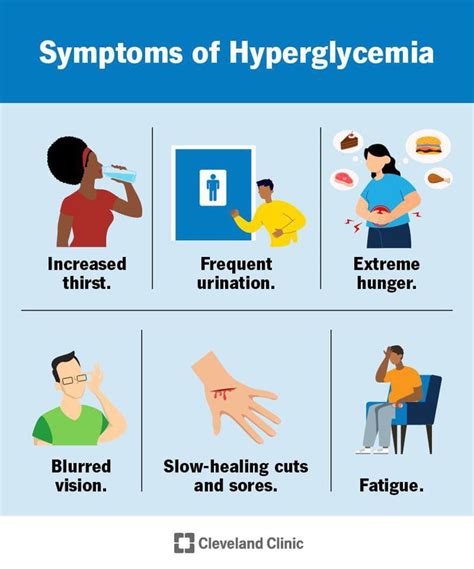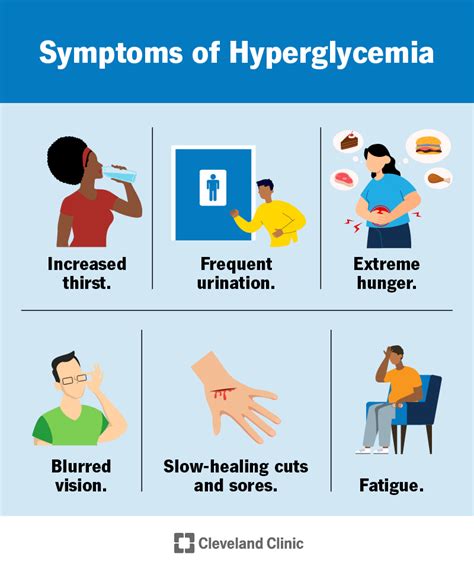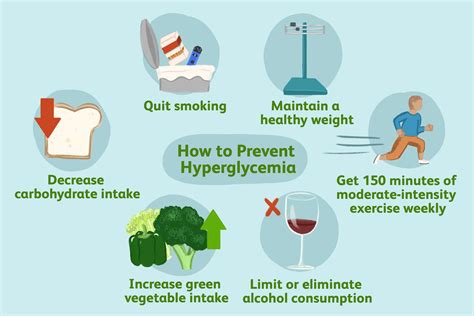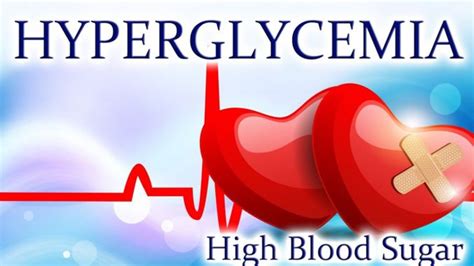Intro
Recognize hyperglycemia signs and symptoms, including high blood sugar levels, increased thirst, and frequent urination, to manage diabetes and prevent complications like ketoacidosis and hyperosmolar syndrome.
Hyperglycemia, or high blood sugar, is a common health issue that affects millions of people worldwide. It is a condition where the blood glucose levels exceed the normal range, and if left untreated, can lead to serious health complications. Hyperglycemia can be caused by various factors, including diabetes, obesity, certain medications, and a sedentary lifestyle. In this article, we will delve into the signs and symptoms of hyperglycemia, its causes, and the importance of early detection and treatment.
Hyperglycemia can be acute or chronic, and its symptoms can vary depending on the severity and duration of the condition. Acute hyperglycemia can cause symptoms such as increased thirst and urination, blurred vision, fatigue, and headaches. Chronic hyperglycemia, on the other hand, can lead to more severe complications, including nerve damage, kidney damage, and increased risk of heart disease. It is essential to recognize the signs and symptoms of hyperglycemia to seek medical attention promptly and prevent long-term damage.
The importance of understanding hyperglycemia cannot be overstated. According to the World Health Organization (WHO), diabetes, which is a primary cause of hyperglycemia, affects over 460 million people worldwide, and this number is expected to increase to 700 million by 2045. Moreover, hyperglycemia is a significant risk factor for various health complications, including cardiovascular disease, kidney disease, and blindness. By recognizing the signs and symptoms of hyperglycemia and seeking early treatment, individuals can reduce their risk of developing these complications and improve their overall health and well-being.
What is Hyperglycemia?

Causes of Hyperglycemia
The causes of hyperglycemia can be broadly classified into two categories: diabetic and non-diabetic. Diabetic hyperglycemia is caused by diabetes, a chronic condition characterized by the body's inability to produce or effectively use insulin. Non-diabetic hyperglycemia, on the other hand, can be caused by various factors, including obesity, certain medications, stress, and a sedentary lifestyle. Other medical conditions, such as polycystic ovary syndrome (PCOS), Cushing's syndrome, and pancreatitis, can also increase the risk of developing hyperglycemia.Signs and Symptoms of Hyperglycemia

Diagnosis of Hyperglycemia
Diagnosing hyperglycemia typically involves a combination of physical examination, medical history, and laboratory tests. The most common test used to diagnose hyperglycemia is the fasting plasma glucose (FPG) test, which measures blood glucose levels after an overnight fast. Other tests, such as the oral glucose tolerance test (OGTT) and the hemoglobin A1c (HbA1c) test, can also be used to diagnose hyperglycemia.Treatment and Management of Hyperglycemia

Lifestyle modifications, such as a healthy diet and regular exercise, can help manage hyperglycemia and reduce the risk of complications. A healthy diet should focus on whole, unprocessed foods, such as vegetables, fruits, whole grains, and lean proteins. Regular exercise, such as walking or swimming, can help improve insulin sensitivity and reduce blood glucose levels.
Complications of Hyperglycemia
If left untreated or poorly managed, hyperglycemia can lead to serious health complications, including: * Cardiovascular disease: High blood sugar levels can increase the risk of heart disease, stroke, and peripheral artery disease. * Kidney disease: Hyperglycemia can damage the kidneys, leading to chronic kidney disease and kidney failure. * Nerve damage: High blood sugar levels can damage the nerves, causing numbness, tingling, and pain in the hands and feet. * Blindness: Hyperglycemia can cause damage to the blood vessels in the eyes, leading to blindness.Prevention of Hyperglycemia

A healthy diet should focus on whole, unprocessed foods, such as vegetables, fruits, whole grains, and lean proteins. Regular exercise, such as walking or swimming, can help improve insulin sensitivity and reduce blood glucose levels. Stress management techniques, such as meditation or yoga, can help reduce stress and improve overall health.
Risk Factors for Hyperglycemia
Certain risk factors can increase the likelihood of developing hyperglycemia, including: * Family history: A family history of diabetes or hyperglycemia can increase the risk of developing the condition. * Obesity: Being overweight or obese can increase the risk of developing hyperglycemia. * Physical inactivity: A sedentary lifestyle can increase the risk of developing hyperglycemia. * Age: The risk of developing hyperglycemia increases with age. * Certain medical conditions: Certain medical conditions, such as polycystic ovary syndrome (PCOS), Cushing's syndrome, and pancreatitis, can increase the risk of developing hyperglycemia.Conclusion and Next Steps

We invite you to share your thoughts and experiences with hyperglycemia in the comments section below. If you have any questions or concerns, please do not hesitate to reach out. Additionally, we encourage you to share this article with friends and family who may be at risk of developing hyperglycemia.
What are the common symptoms of hyperglycemia?
+The common symptoms of hyperglycemia include increased thirst and urination, blurred vision, fatigue, headaches, and slow healing of cuts and wounds.
How is hyperglycemia diagnosed?
+Hyperglycemia is typically diagnosed using a combination of physical examination, medical history, and laboratory tests, including the fasting plasma glucose (FPG) test, the oral glucose tolerance test (OGTT), and the hemoglobin A1c (HbA1c) test.
What are the complications of hyperglycemia?
+The complications of hyperglycemia include cardiovascular disease, kidney disease, nerve damage, and blindness.
How can hyperglycemia be prevented?
+Hyperglycemia can be prevented by maintaining a healthy lifestyle, including a balanced diet, regular exercise, and stress management.
What are the risk factors for hyperglycemia?
+The risk factors for hyperglycemia include family history, obesity, physical inactivity, age, and certain medical conditions, such as polycystic ovary syndrome (PCOS), Cushing's syndrome, and pancreatitis.
